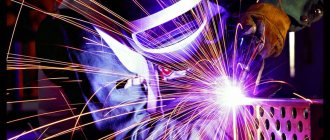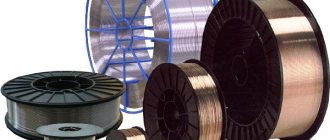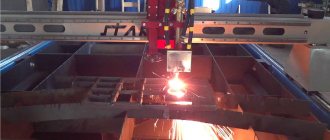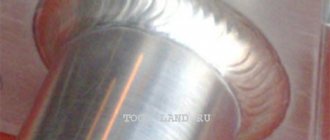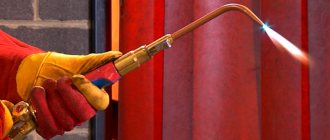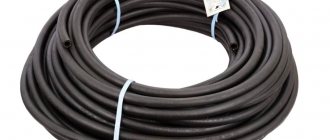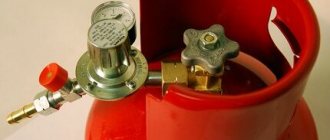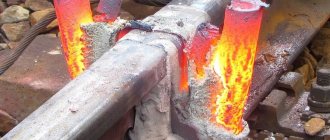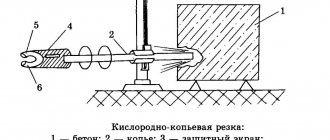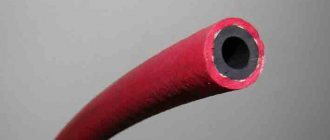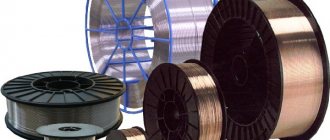Acetylene, hydrogen, natural gas and others are used as flammable gases for gas welding. Gas mixtures are also used for welding, such as petroleum gas, propane-butane gas mixture, and pyrolysis gas. In addition, gas welding uses vapors of flammable liquids - gasoline and kerosene.
The table shows the most common gases and gas mixtures for gas welding and gas cutting, indicating their main properties and scope of application:
Gas
| Density under normal conditions, kg/m2 | Heat of combustion under normal conditions, kJ/m3 | Flame temperature in a mixture with oxygen, °C | Acetylene replacement rate | Explosion limit (%) when mixed with: | Application area | ||
| air | oxygen | ||||||
| Acetylene | 1,09 | 529200 | 3200 | 1 | 2,2-81,0 | 2,3-93,0 | All types of gas welding |
| Hydrogen | 0,084 | 10080 | 2400 | 5,2 | 3,3-81,5 | 2,6-95,0 | For welding thin metal (up to 2mm), welding cast iron, aluminum, brass |
| Coke | 0,4-0,55 | 14700-18480 | 2000-2300 | 3,2 | 4,5-40,0 | 40,0-75,0 | For soldering, welding of low-melting metals, oxygen cutting |
| Oil | 0,87-1,37 | 36540-62160 | 2000-2400 | 3,0 | 3,8-24,6 | 10,0-73,6 | Same |
| Methane | 0,67 | 33600 | 2400-2700 | 1,6 | 4,8-16,7 | 5,0-59,2 | Same |
| Propane | 1,88 | 87360 | 2600-2800 | 0,6 | 2,0-9,5 | 2,0-48,0 | Soldering and welding of non-ferrous metals, gas cutting, welding of steels up to 6 mm thick, straightening, fire cleaning |
| Butane | 2,54 | 116760 | 2400-2500 | 0,45 | 1,5-8,5 | 2,0-45,0 | Same |
| Petrol | 0,7-0,76 | 42840 | 2400 | 1,4 | 0,7-6,0 | 2,1-28,4 | Gas cutting of steels, soldering and welding of low-melting metals |
| Kerosene | 0,82-0,84 | 42000 | 2300 | 1,6 | 1,4-5,5 | 2,0-28,0 | Same |
The choice of one gas or another for welding depends not only on the temperature of the flame, but also on the amount of heat (calorific value) that is obtained during its combustion. The acetylene replacement coefficient indicated in the table is the ratio of the replacement gas consumption to the acetylene consumption at the same effective thermal power. This coefficient is necessary if it is necessary to replace acetylene with another flammable gas.
Acetylene for gas welding
Acetylene is one of the most common gases used for gas welding. Acetylene has become most widespread due to the fact that the acetylene-oxygen gas flame has the highest temperature compared to other flammable gases and gas mixtures (see table above).
Acetylene is formed by the interaction of calcium carbide CaC2 with water. Calcium carbide is able to absorb moisture from the atmosphere and decompose under its influence. Therefore, it is stored in sealed steel roofing drums. The capacity of such drums is 100-130 kg. Calcium carbide is obtained by fusing coke and burnt lime in electric furnaces:
CaO + 3C = CaС2 + CO
Acetylene C2H2 is a chemical compound of carbon and hydrogen. To produce acetylene, acetylene generators are used, into which carbide and water are loaded. The chemical interaction of calcium carbide and water proceeds intensely, with a large release of heat Q:
CaC2 + 2H2O = C2H2 + Ca(OH)2 + Q
From 1 kg of calcium carbide you can get up to 300 liters of acetylene. Under normal conditions, acetylene is colorless and has a strong, specific odor. Acetylene is lighter than air, its density is 1.09 kg/m3.
Acetylene is explosive if it is mixed with air and its concentration is 2.2-81% by volume. When mixed with oxygen, acetylene is explosive at a concentration of 2.8-93% by volume. The most explosive are acetylene-oxygen mixtures containing 7-13% acetylene.
When dissolved in liquid, the explosiveness of acetylene is significantly reduced. In practice, acetylene is dissolved in acetone, 1 liter of which can dissolve up to 20 liters of acetylene. We talked about this in the article: “Gas cylinders for welding. Gas welding cylinders."
In addition to calcium carbide, sources of acetylene include natural gas, oil and coal. Acetylene obtained from natural gas is called pyrolysis acetylene.
Characteristics
Let us dwell in more detail on the various types of gaseous substances used for welding work.
- Argon
Most often used for these purposes. There is even a separate welding method that uses its name - argon arc. Inert, colorless and odorless, not chemically active towards metals and other substances. Much heavier than air, due to this it creates a reliably protected zone in the welding area.
- Helium
It comes second in popularity. It is also inert, however, unlike argon, helium is lighter than air. Due to this, much more is consumed.
Considering that its cost is noticeably higher than that of argon, this is a significant drawback. However, this does not prevent its frequent use.
Hydrogen for gas welding
Hydrogen is a colorless, odorless gas. When mixed with oxygen or air, it forms an "explosive gas" which is explosive. Therefore, in the case of using hydrogen for welding metals, it is necessary to strictly adhere to safety rules during its storage, transportation and use.
Hydrogen is stored and transported in steel gas-welding cylinders at a pressure not exceeding 15 MPa. It can be obtained by decomposing water into hydrogen and oxygen using electrolysis. Hydrogen is also synthesized in special hydrogen generators by a chemical reaction of sulfuric acid H2SO4 and zinc or iron filings. In this case, zinc or iron sulfates are formed, and the released hydrogen accumulates inside the generator.
What to use for cutting?
Cutting involves a completely different principle of using gas. Here you need to use the same gases that react with oxygen and metal in order to destroy the working surface as quickly as possible.
- Oxygen. The cheapest, but at the same time, the most inefficient gas.
- Acetylene. The optimal choice for all types of welding. Not suitable for very thin surfaces.
- Pseudo-acetylene or its substitutes. Not a cheap option, especially when it comes to large quantities. Provides premium quality and high speed.
Petroleum gas, natural gas and propane-butane mixture for gas welding
Pyrolysis gas is a mixture of flammable gases formed during the breakdown of oil, fuel oil and other petroleum products when exposed to high temperatures. Pyrolysis gas contains sulfur compounds, which cause corrosion of mouthpieces in gas welding torches. Therefore, this gas undergoes thorough purification before use.
Petroleum gas is a by-product of oil refineries. It is mainly used for cutting and welding thin metals and for welding non-ferrous metals.
Propane-butane mixtures are colorless and odorless mixtures. They consist of propane C3H8 and butane C4H10. This mixture has the highest calorific value, i.e., when it burns, the greatest amount of heat is released.
Coke gas
Coke oven gas is a colorless flammable gas with the odor of hydrogen sulfide. Coke oven gas is produced by producing coke from coal; it consists of a mixture of gaseous combustible products of hydrogen, methane and other unsaturated hydrocarbons. Mainly used for cutting steels, welding and soldering low-melting non-ferrous metals. For welding and cutting, coke oven gas is used, purified from sulfur compounds and resinous substances. For complete combustion of 1 m3, 0.9 m3 of oxygen is required. Coke gas is supplied to the welding and cutting site through pipelines at a pressure of 1.3-1.5 kPa.
Propane
Technical propane is a colorless flammable gas with a pungent odor, consisting of propane C3H8 or propane and propylene C3H8, the total content of which must be at least 93%. Propane is obtained by processing petroleum products. Under normal conditions, propane is in a gaseous state, and when the temperature decreases or pressure increases, it turns into a liquid state. Thus, at a temperature of 293 K, propane transforms into a liquid state at a pressure of 0.85 MPa. Evaporation of 1 kg of liquid propane produces 0.53 m3 of vapor.
Propane-butane mixture is a colorless flammable gas with a pungent odor and is a by-product of oil refining.
The mixture easily turns into a liquid state, for example, at a temperature of 233 K, a propane-butane mixture liquefies at atmospheric pressure. Liquefied gases are stored only in closed containers, since liquid evaporation occurs even at 273 K.
The density of propane-butane is greater than the density of air, so it is necessary to carefully monitor the tightness of equipment and communications to avoid the formation of an explosive mixture of gas and air below the room. Filling containers with propane and a propane-butane mixture, transporting them, as well as draining the gas must be carried out in accordance with the “Rules for the design and safe operation of pressure vessels” approved by Gosgortekhnadzor.
Propane-butane mixtures are widely used in cutting steel, welding and soldering low-melting non-ferrous metals, hardening, and gas welding of plastics. The mixture is delivered to the welding site in steel cylinders under a pressure of 1.6 MPa or through gas pipelines through a bypass ramp. When 1 kg of propane evaporates, 500 dm3 of gas is formed.
City gas
City gas is a compound flammable gas. Typically, the main component of city gas is natural gas, to which coke oven and generator gases are added. The composition of city gas is not constant; Moscow type gas has the following composition: methane (70-95%), hydrogen (up to 25%), heavy hydrocarbons (up to 1%), nitrogen (up to 3%), carbon monoxide (up to 3%), carbon dioxide (up to 1%), oxygen (up to 0.5%). City gas is delivered to the welding site through pipelines. As a substitute for acetylene, it is used for cutting steels, welding and soldering low-melting non-ferrous metals.
Description of welding technology
Gas welding technology has some features. There are several options for carrying out the work.
Right and left
There are right and left welding patterns. The first option is used most often. It involves moving the burner from the right edge to the left. In this case, the flame jet is directed directly at the wire, which is advanced in front of the burner. This method is often used to weld small parts, thin slabs and materials that melt even at low temperatures.
The second option involves moving the burner from the left edge to the right. In this case, the wire is advanced after the flame. Left-hand welding provides deeper impact and better adhesion.
Multilayer method
This method is used when it is necessary to form a high-strength seam. It involves annealing the lower layer and further surfacing the upper one. Thus, all layers are calcined. This has a positive effect on the quality of the seam.
Through roller
This method requires gradual melting of the upper edge of an existing hole in the workpiece, followed by the application of molten metal to the lower edge of the hole. To carry out the work, it is necessary to fix the metal sheets vertically. Thus, the seam takes the shape of a roller.
Welding pools
This method involves the formation of trays along the seam. A filler wire is introduced into each such formation, which melts and fills the voids. The nozzle moves to a new area, and the next bath overlaps the previously created one.
Oxidizing flame
The method is used to connect elements made of low-carbon steel alloys. The flame in this case oxidizes the material, which leads to the formation of iron oxide. For deoxidation, filler wire is used, including silicon and manganese.
Necessary equipment for gas welding
Gas welding equipment is used to join or cut metal elements under high temperature. It involves the use of different types of devices and accessories, depending on the type of work performed. Several components are used to process metal.
Water or liquid seal
Protects parts of devices from the backlash of the welding flame. This can happen when the gas flow rate is less than the combustion speed, or when the burner mouthpiece passages are clogged. All generators are equipped with this safety device.
Gas cylinders
Special cylindrical tanks with valves for storing and transporting chemicals. You can tell what type they contain by color.
Gas cylinders for welding
Gearbox
Reduces gas pressure or keeps it at a certain level. The device is available in direct and reverse action. This is an important element of gas equipment that determines the performance of the entire system. There are different types of devices, including an oxygen reducer. It is adapted to aggressive environments and has blue markings.
For gas welding, as a rule, the simplest single-chamber gearboxes are used
Gas hose
Provides supply of flammable liquids. It is made using special technology. This is a multi-layer product that can withstand aggressive environments, with an internal diameter of no more than 16 mm. Depending on the category, hoses are marked red, yellow and blue.
Gas hoses
Gas-burner
It is the main part of welding equipment. It produces a flame, which is necessary for heating and melting metal. By design, the product comes in two types: injection and non-injection. The gas burner operates at different powers. The choice depends on the amount of gas supplied per unit time.
Gas burner diagram
Special table
Increases the welder’s work convenience, as it performs several functions:
- fixes workpieces;
- stores auxiliary tools;
- is a ground loop.
The design may have a rotating or static tabletop.
Welding table diagram
Occupational Safety and Health
The specifics of gas welding, cutting and surfacing of metals and their alloys impose special, additional (increased) requirements for safety, for the safe organization of workplaces, maintenance of gas equipment and equipment, as well as for methods of organizing safe work.
Combustible gases, when mixed with air or oxygen, form explosive mixtures that can explode from a spark of any origin; acetylene is explosive even in the absence of oxygen or air, since with increasing temperature and pressure it can decompose into carbon and hydrogen, releasing a large amount of heat. In addition, with copper and silver, acetylene forms explosive compounds that explode at the slightest impact or heat. No less danger arises when producing acetylene in generators, as well as when storing and opening drums with calcium carbide.
Oxygen, which is in a cylinder under pressure, has high chemical activity, especially when in contact with mineral oils, as well as fats of vegetable and animal origin.
During gas welding and cutting of metals and their alloys, gases, vapors, dust and metal oxides that are harmful to health enter the air of the working area. Therefore, strict and strict adherence to all safety rules and industrial sanitation, a clear understanding of the reasons that can cause this or that danger, as well as knowledge of the necessary measures and methods for its prevention guarantee the safe performance of the work carried out and the preservation of the health of welders.
Basic properties of gases used in gas welding work
Each gas welder (gas cutter), their assistants, as well as persons involved in the storage and transportation of gas cylinders, must be well aware of the basic properties of the gases with which they have to work.
Oxygen (O2)
– a colorless, odorless gas, heavier than air (weight of 1 m3 of oxygen at 0°C = 1.429 kg, weight of 1 m3 of air = 1.293 kg). For gas welding work, oxygen is obtained from atmospheric air (atmospheric air contains about 28% oxygen) by deep cooling followed by nitrogen separation or by electrolysis of water.
This method of obtaining oxygen from air is the most common, since in this case it is possible to obtain almost any amount of oxygen of the required purity with the least expenditure of energy. At a temperature of – 183 0C and a pressure of 760 mm Hg. Art. oxygen turns into an easily mobile bluish liquid, and from one liter of liquid oxygen about 860 liters of gaseous oxygen are formed.
Oxygen does not burn, but supports combustion, energetically entering into a chemical combination with almost all substances. Contact of oxygen under high pressure with oils, fats, coal dust, fabric lint, etc. leads them to instant oxidation, ignition and explosion at normal temperatures, although the ignition temperature of these products is significantly high (200 - 450 0C).
Porous organic substances (coal, peat, soot, wool, fabrics) saturated with liquid oxygen can explode from a spark, flame and other sources of thermal impulses. Therefore, when using compressed or liquefied oxygen, it is necessary to carefully ensure that it does not come into contact with flammable and combustible substances, including oils and fats of mineral, vegetable or animal origin.
Oxygen is stored and transported in special steel cylinders or tanks with special thermal insulation.
When gas welding, surfacing and cutting of metals and their alloys, various flammable gases are used as fuel: acetylene, hydrogen, natural and petroleum gases, vapors of liquid petroleum products (gasoline, kerosene) and others. Burning in oxygen, these gases develop a fairly high flame temperature (acetylene up to 3200, hydrogen up to 2100, propane up to 2000, butane up to 2100, gasoline vapor up to 2400 and kerosene vapor up to 2100 0C). The highest flame temperature is observed during the combustion of acetylene in oxygen. An acetylene flame can practically melt all existing refractory metals and their alloys. Other gases with a lower flame temperature are used as acetylene substitutes.
Acetylene (C2H2)
is a chemical compound of carbon and hydrogen, is a colorless gas, lighter than air, with a faint ethereal odor. Technical acetylene, used for gas welding and cutting metals, has a strong, unpleasant odor due to some impurities present in it. When acetylene burns in oxygen, the flame temperature reaches 32,000. Acetylene is explosive in a mixture with air if it contains from 2.8 to 80% acetylene by volume and in a mixture with oxygen if acetylene contains from 2.8 to 93% by volume.
These mixtures may explode from a spark from an open flame or strong heat.
When heated to 450 - 5000 and a simultaneous increase in pressure to 1.5 - 2 atm, acetylene explodes, forming a blast wave with a pressure 10 - 11 times greater than the initial absolute pressure of acetylene.
The explosiveness of acetylene is greatly reduced when placed in thin (capillary) vessels. This property of acetylene is used when filling pressure cylinders with acetylene. Acetylene is lighter than oxygen and air. The density of acetylene in relation to air is 0.9, and in relation to oxygen – 0.8. With prolonged contact of acetylene with red copper and silver, acetylene copper or acetylene silver is formed, which explode when heated to 110 - 1200 and upon strong impact. Therefore, these metals are not used for the manufacture of acetylene equipment.
When acetylene is heated to 300 0C, its polymerization can occur, which consists in the fact that acetylene molecules become denser and it turns into benzene and other products. Polymerization occurring with insufficient heat removal can lead to an explosion of acetylene and destruction of acetylene generators. To prevent the possibility of polymerization and explosive decomposition of acetylene, the temperature in acetylene generators should not exceed 100 0C.
A very important property of acetylene is its ability to dissolve in many liquids: acetone, benzene, gasoline, etc. The best solvent for acetylene is acetone: at a temperature of +10 0C, 26 liters of acetylene dissolve in one liter of acetone. The degree of solubility of acetylene in acetone largely depends on the ambient temperature. As the ambient temperature increases, the solubility of acetylene in acetone decreases.
To natural gases
include all flammable gases that are extracted from the bowels of the earth or accompany oil during its extraction from oil fields. The latter are called passing.
Natural gas mainly consists of methane (CH4), the content of which ranges from 85 to 98%. The remaining 15 - 20% are nitrogen, ethane, propane, hydrogen sulfide, etc. Natural gas is light (specific gravity in air 0.55 - 0.73), colorless, odorless (and therefore dangerous), non-toxic, but is an asphyxiating gas. To give the gas a characteristic sharp unpleasant odor, an odorant is added to it (16 g per 1000 m3 of gas).
Natural gas is also dangerous because, when burned incompletely, it releases carbon monoxide (CO) - carbon monoxide - colorless and very poisonous.
When the air contains 0.5% carbon monoxide, death occurs in a person within 20–30 minutes; 1% gas after several breaths leads to loss of consciousness, and after 1–2 minutes – to death.
In recent years, natural gas has become widely used in the practice of flame processing of metals, in particular for gas cutting of metals.
The explosive limits of a mixture of natural gas and air are significantly lower than the explosive limits of acetylene-air mixtures. These limits range from 3.8 to 17% by volume.
Liquefied gases, propane-butane mixtures
obtained through the process of liquefying them for ease of storage and transportation. Liquefied gases are usually called mixtures of hydrocarbons - propane (C3H8), butane (C4H10) in amounts from 5 to 30%. They are also called technical propane (GOST 10196-62), and sometimes liquefied petroleum gases. Under normal conditions, this mixture is a gas, and at temperatures below +20 0C or pressures above atmospheric pressure, the mixture of gases condenses, turning into a liquid state.
Recently, especially for gas cutting of metals and their alloys, liquefied gases - propane and butane, as well as their mixtures, have become widely used. At ordinary temperatures and low pressure, propane-butane mixtures easily pass from a gaseous state to a liquid state.
Liquefied gases are heavier than air (the specific gravity of propane in air is 1.253, butane - 2.007), they can accumulate in low places - trenches, wells, pits and other depressions, forming propane-butane explosive mixtures with air, which can explode from any source of thermal impulse – sparks from an open flame, etc. Therefore, before starting hot work, it is necessary to ensure that there are no explosive mixtures.
The positive properties of propane-butane mixtures are their low explosive limits. For example, the explosive limits of propane mixed with air range from 2 to 305% of propane parts by volume. This is several times lower than the explosive limits of acetylene with air. Propane, butane and their mixtures are stored and transported to the point of consumption in special cylinders or tanks under a pressure of 16 kgf/cm2. At this pressure, propane-butane mixtures are in a liquid state. Containers are usually filled to no more than half their volume, since when liquefied gas expands when the cylinder is heated, the pressure in it can sharply increase and cause the cylinder or tank to explode. Therefore, cylinders and tanks filled with a propane-butane mixture are protected from heat and shock.
Gasoline and kerosene vapors
used in gas welding, surfacing and cutting metals as fuel.
Gasoline is a transparent, easily mobile liquid with a specific odor, consisting of hydrocarbons that boil away from oil at temperatures from 35 to 250 o. Gasoline is very volatile and evaporates at any temperature, but the rate of evaporation increases with increasing temperature. Gasoline vapors mix with air to form steam-air explosive mixtures.
The explosiveness of gasoline vapor-air mixtures is lower than the explosiveness of acetylene-air mixtures (within 0.65 to 8.5% of gasoline vapor by volume). In addition, gasoline vapors entering the human body can cause acute chronic poisoning. Gasoline (kerosene) is transported to the place of consumption in a closed metal container.
Kerosene
Kerosene is also a product of petroleum refining and is a colorless yellowish liquid that evaporates easily. Kerosene used for welding and cutting metals must meet the requirements of TU 38.71-58-10-90. Kerosene is also used for welding and soldering low-melting non-ferrous metals.
So, we have learned that acetylene is the main combustible gas for gas welding, but other, less expensive gases are used for gas cutting, which allow the cutting process to be carried out without a significant loss in productivity and quality.
